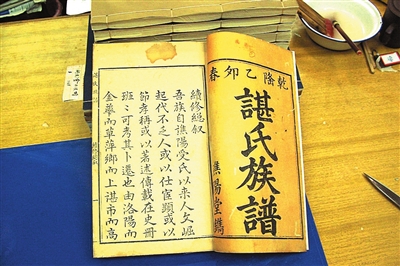Genealogical research shifts its focus to family culture

The picture shows the preface of the Records of Chen Family Tree in the Qing Dynasty. At that time, the opening lines and format of the preface were obviously simplified, since the patriarchal system was deeply rooted in Chinese family culture.
Research into family ancestry is one of the main forms of ancient social history research, particularly in regard to the Ming (1368-1644) and Qing (1616-1911) dynasties. In recent decades, the introduction of anthropological research methods has helped scholars explore the interactions between families and local communities. This includes research into memorial ceremonies in graveyards and ancestral temples, which is built upon previous research subjects, including family research and examinations into ancestral temples and common family property, which have tended to focus on the combination of culture construction and theorizing about family backgrounds.
As part of this recent change in ancestry research, genealogical research, which regards family trees as a major element, has become increasingly focused on cultural production and how families were formed.
Throughout the history of Chinese patriarchal clans, genealogy has played a significant role in family development. In ancient China, scholars of each dynasty emphasized genealogy and conducted genealogical research. From bronze inscriptions in the Shang (1600-1046 BCE) and Zhou (1046-256 BCE) dynasties to a stele of a genealogical tree in the Han Dynasty (206 BCE-220 CE), there have been different forms of family trees in a broader sense. Since the Song Dynasty (960-1279), new records of family trees copied the preface of the family trees of famous writer Ouyang Xiu (1007-1072) or Su Xun (1009-1066) as reference points and the prefaces for family trees gradually became modeled upon these. In the early Ming Dynasty, the families were organized according to the theoretical basis of Family Rituals, by famous Confucian scholar Zhu Xi (1130-1200). Family Rituals introduced ancient Chinese social customs and rituals of weddings, funerals and worship ceremonies, which had a great influence on ancient China.
During the Song Dynasty to the Ming and Qing dynasties, the literary form of the preface of family trees was standardized. The opening lines and format of the preface generally introduce the function of a family tree as well as the origins and branches of a family. In the preface of genealogical trees in the Ming Dynasty, patriarchal systems and Confucian ethics were repeatedly mentioned in a particular format. On the one hand, Ming family trees stressed that the function of a family tree is to clarify lineage and combine patriarchal clans, a format which was based on Ouyang Xiu and Zhu Xi’s understanding of Confucianism. On the other hand, it compared family history with national history, which improved the symbolic meaning of family trees. In contrast, the format for the preface of family trees in the Qing Dynasty was obviously simplified since Confucian culture and the patriarchal system were deeply rooted in Chinese family culture.
Wang Rui is from the Institute of History at the Chinese Academy of Social Sciences.

 PRINT
PRINT CLOSE
CLOSE